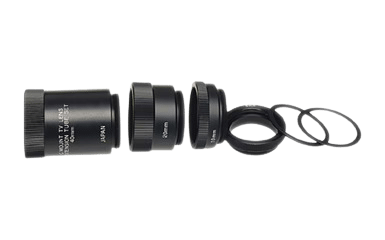Let’s take a closer look…
Most lenses, with the notable exception of M-12 lenses, have some form of focus adjustment on them, enabling the lens to focus on objects with different working differences. The range of a C-mount lens’ focus is determined by its design. The vast majority being able to focus at infinity down to the order of cm.
Now, having a range of focus that is infinitely large sounds wonderful in practice, however sometimes the application requires us to focus on a subject that is closer than the minimum working distance, or maybe that a smaller FOV is to be observed.
Enter the spacer.
Changing the game
With the introduction of any spacer, this changes the range of working distances that the lens can focus on objects in. Out goes the possibility of focusing at infinity and we must hence embrace a finite range of focusable working distances.
As mentioned, another possible reason for needing a spacer is to observe a smaller region i.e. to increase the magnification. The Working distance and magnification are related by the imaging equations formulated by the frustratingly clever Carl Friedrich Gauss:

Where d is the image distance (the distance from the lens to the sensor when the object being imaged is in focus), f is the focal length, and WD is the working distance.
The flip side
There are other effects that come into play when such an arrangement is employed. Since we are changing the optical properties of the light from a subject entering the lens, it follows that the optical performance of the lens changes somewhat. Since most machine vision C-mount lenses are designed to work without a spacer the majority of the time, it follows that this is where their optimal performance will ly, (even lenses that cannot focus at infinity, and hence have spacing designed into them are still hence designed to work without an additional spacer).
The decrease in performance is seen in the lens’s MTF curve, and aberrations. As such using monochromatic light and a mono camera can reduce chromatic aberration. As a rough guide, the maximum spacer size shouldn’t be more than half the focal length of the lens in question, and since lenses with longer focal lengths generally give better performance with spacers than their shorter focal lengths counterparts. This is solely due to the face that a longer focal length bends light less than a shorter one, hence are of comparatively simpler design.
See a spacer kit with multiple options here.
In short, spacers, like most things, confer advantages and disadvantages in certain situations and these should be considered and/ or examined before implementing a spacer.

